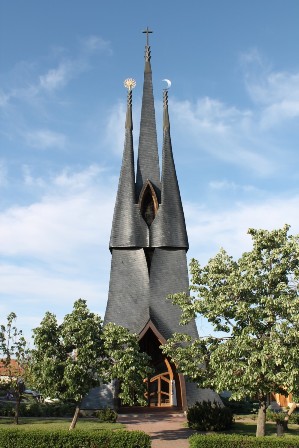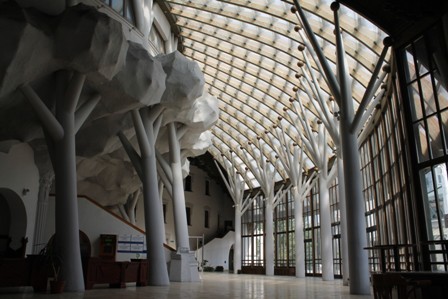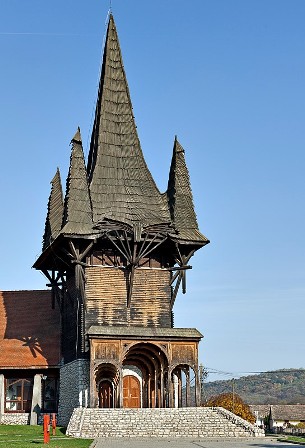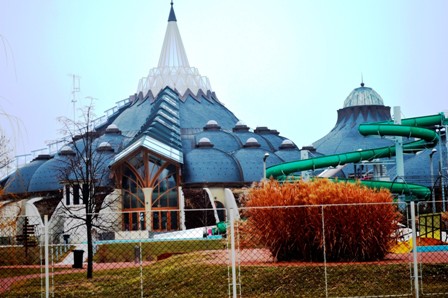In the second half of the nineteenth century, after the reconstruction of the Habsburg Empire, Hungary entered the most successful period of its history. The architecture was particularly successful, and in that period the unified Budapest got a look that, despite all the later misfortunes, ensures it to this day the status of one of the most beautiful cities in the world. Just imagine what impression that city left on its visitors a little more than a century ago – the largest parliament in the world, the largest synagogue in the world, the oldest continental subway, railway stations, public buildings, bridges…
A special attraction were, and still are, buildings in the Secession style, as Art Nouveau was called in Hungary, an unusual, profoundly revolutionary artistic direction that took over Europe at the turn of the twentieth century. It seems that nowhere, except perhaps in Catalonia, has this style been embraced with such enthusiasm and popular support as in Hungary. Hungarian architects decorated their buildings not only with unusual, floral, rounded forms, but with much patriotic enthusiasm, and decorations from folk tradition. The most common motifs were stylized Szekler decorations from the mythologized Transylvania, but sometimes the eastern origin of the Hungarians was especially emphasized, so Middle Eastern and even Indian motifs were used, historically unjustified. Be that as it may, Hungarian architects at the turn of the 20th century successfully combined Art Nouveau and national romanticism, and the great cities of Hungary shone with a splendor that was never reached again. In that period, cities outside the territory of today’s Hungary were also significantly beautified, especially those in Transylvania, then Subotica, and especially the nearby fashionable resort – Palić.
Hungarians especially appreciate the architect Lechner Ödön, whom they say is the founder of the direction and the most important representative, but the works of his followers were equally successful. Among others, Lajta Béla stood out, then Magyar Ede, who worked in Szeged, and the creative tandem of Komor Marcell and Jakab Dezső, authors of the most important buildings in Palić and Subotica. It should be emphasized that some of the architects who marked the Hungarian Secession were our compatriots, born in Vojvodina. The most successful among them were Gyula Pártos, Lechner Ödön’s business and creative partner, and Raichle Ferenc, perhaps the most talented architect of the Hungarian Art Nouveau, who were both born in Apatín. All of them are the pride of the nation today and are widely celebrated in Hungary.
Architecture in difficult times
The outcome of the First World War and the collapse of the Monarchy brought an abrupt end to that successful period. Overnight, Hungary became a small and insignificant country, a world champion in suicides. In one period it was under the patronage of Nazi Germany, and later Soviet Russia, not exactly the best society for creative activity. It’s no wonder that architecture flourished, and architects more or less stamped the buildings imposed on them by the politically powerful, but ideologically blinded neighboring states. asks him. Nevertheless, at the beginning of the 80’s, in the circumstances of somewhat loosened communism, he founded his bureau and began to design completely different objects, with which, in a slightly modified form, he brought Hungarian Art Nouveau out of the darkness of nostalgia and into the light of day. While the representatives of the regime raised their eyebrows with concern, the general public accepted it with open approval and a faint hope for the return of the glory days of Hungarian architecture was awakened in it.

Imre Makovecz – the awakened hope of Hungarian architecture
A few years later, the political regime was fundamentally changed and Hungary got a new historical chance. The new, democratic Hungary was far from the epitome of cosmopolitan liberalism. On the contrary, it turned out to be a conservative country, where God and traditional values are believed, history is mythologized and heroes from the past are glorified. It doesn’t sound very great, but after all, it was good enough for Hungarian architecture to raise its head after decades of lethargy. Of course, considering his already established reputation, Mr. Makovecz became a kind of national hero and favorite of that new Hungary.
In the meantime, he had already developed his style to a great extent, with which he not only revived the Hungarian Art Nouveau, but also modernized it, simplified the decoration and enriched it with forms of organic architecture. As a standard, his buildings have tree-like concrete columns in which the “branches” are statically and logically placed in such a way as to reduce the spans of beams and arches, and they themselves are loaded almost only by pressure and carry out the forces to the “trunk” in a logical way.

Roof structures are always wooden, most often they are arches made of laminated wood, with which Makovecz forms the shapes of his buildings in accordance with their purpose and location. He also has some of his favorite decorations, sometimes strange ones, which appear on many objects. One of the frequent motifs are some kind of wings, in all probability angelic, because, imagine, Mr. Makovecz was not only a believer, he also believed in angels. Sometimes, as in the Roman Catholic church in Pax or in the Reformed church in Cluj, in imitation of the secessionists, it uses the crescent moon and the Hindu sun, as symbols of the mythical “East”, in the broadest sense of the word, from where the Hungarian tribes trace their origins.

Given his status in post-communist Hungary, Mr. Makovecz could have his pick of the best jobs, and probably, if he had asked for it, he would have had no problem designing some important state buildings in the center of Budapest, where millions of tourists and influential foreign architectural critics would see them. Instead, Mr. Makovecz decided to build his buildings in the villages and small towns of the Hungarian provinces, where their aesthetics really originate. In those small Pannonian towns, his buildings are the main attraction, and they leave the deepest impression when, spontaneously, completely unprepared, you stumble upon one of them by chance. the Hungarian plain that few people outside of Hungary have even heard of: Sarospatak (literally Muddy stream), Kakasd (let’s say “Petlovac”), Piliscaba, Siofok, Százhalombatta, but sometimes also cities abroad, where Hungarians live, most often, of course, in Transylvania.
In some cities, he even got the opportunity to design more and more important buildings, giving them a somewhat personal character with his specific aesthetics. Such, for example, are the cities of Csenger and Sarospatak, and especially the city of Makó, which is still known to many of our compatriots because of its spa and proximity to the border with Serbia.

In the central city hotel in Mako, you can even get instructions for a “Makovecz tour”, i.e. a visit to the facilities he designed in that city, including a theater, bus station and spa facilities. By the way, the city is known as the center of onion production, so, in accordance with its organic principles, Makovecz used this as the main motive for the design of the theater and spa “Hagymatikum” (hagyma = onion)Imre Makovecz’s opus, specific and extensive, and in addition to being located in places rarely visited by foreigners, it is highly noted by the professional public abroad and highly regarded as a prime example of consistent organic architecture. For his work, Makovecz received numerous awards and was a member of the world’s most prestigious architectural associations, and in Hungary his influence went beyond the framework of architecture, so he was the founder of the Hungarian Academy of Arts and its president for life, and in politics he provided significant support to conservative parties. As an illustration of the importance of his work for the Hungarian public, we should mention that even a bizarre conspiracy theory was created around his personality, according to which he was actually a Satanist, and that his objects are full of inverted crosses, Horus’s (therefore, not angelic) wings and other pagan occult symbols. What an honor. Is there a greater recognition than when local envious people declare you a Satanist?

Of course, restoring Hungarian architecture to its former glory is not a one-man job. Imre Makovecz did as much as he could, but now others must follow the path he blazed. If we use the historical analogy, and accept him as the Lechner Ödön of the new age, then we have yet to see who will be the new Rachel Ferenc, and whether a new creative tandem for the twenty-first century will appear at all, as they once were Jakab and Komor.

